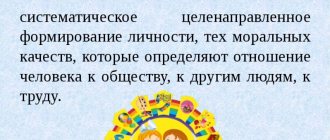INTRODUCTION
Work becomes a great educator when it enters the lives of our students, gives the joy of friendship and camaraderie, gives birth to new beauty in the world around us, awakens the first civic feeling - the feeling of the creator of material wealth, without which human life is impossible
V.A. Sukhomlinsky
Friendship is a form of interpersonal relationships based on common interests and mutual affection. In preschool children, friendly relationships begin to develop in the process of communication in the kindergarten group. The beginning of a child's friendship is a valuable manifestation of humane feelings and real actions that include responsiveness, a desire to take into account the interests of a friend, and to protect him. Issues of nurturing friendly relationships, the importance of nurturing friendship in preschool children were covered in the works of many prominent teachers and psychologists: R.S. Bure, L.S. Vygotsky, A.D. Kosheleva, A.S. Makarenko, D.V. Sergeeva, and other authors who noted that it is necessary to cultivate friendly relations in children from preschool age. And in kindergarten there are many opportunities for this: in the process of everyday communication with peers, children learn to live in a team, master in practice moral standards of behavior that help regulate relationships with others. At the same time, it is necessary to pay great attention to the independently arising associations in children, to the content and forms of their communication, to look for ways in activities that allow children to learn how to interact, communicate, and make friends correctly. Along with play and artistic creativity, collective work is one of the means that promotes the development and education of preschool children. Work gives the child the opportunity to show real concern for other people, and also instills the skills of cooperation and collectivism - the ability to work together and amicably, helping those around him. At the same time, it should be noted that in the process of managing work, teachers pay more attention to the formation of labor skills and the ability to work independently. Therefore, the search for effective methods and techniques that promote the formation of friendly relationships among children in the process of work is relevant. A wide range of relationships are formed between preschool children during games, joint work activities and in classes. Feelings of sympathy and friendliness appear in children very early. The nature of children's relationships depends mainly on the conditions of upbringing in the family and kindergarten. The teacher encourages children's friendship and at the same time cultivates relationships that are not limited to the interests of only two or three children who are friends with each other, but are of great importance for the development of friendly relations among all students in the group. With this approach, friendly expressions of preschoolers acquire a truly humane orientation and contribute to their cohesion. When a child enjoys work, he strives to achieve good results. This makes the child’s character strong-willed and purposeful. Work brings out good qualities in children. Work done on one's own and worthy of praise brings satisfaction and pleasure to the child. Work should enter a child’s life joyfully and help in successful all-round development. In the process of labor activity, a person not only changes nature, but also changes himself. Work influences the development of a person’s mental abilities; It is in work activity that a person demonstrates his creative activity, develops, and improves his creative inclinations. In the process of labor, a person’s moral relations are formed, his physical improvement occurs, and his labor skills develop. The topic of labor has long been of concern to the best minds of humanity. Below are some thoughts and statements about the work of famous cultural, scientific and political figures. . “Nothing ennobles a person like work. Without work, a person cannot maintain his human dignity” (L.N. Tolstoy); . “Work is the father of pleasure” (Stendhal); . “Work saves us from three great evils: boredom, vice and want” (Voltaire);
. “By the degree of greater or lesser respect for work and by the ability to evaluate work ... according to its true value, you can determine the degree of civilization of the people” (N.A. Dobrolyubov);
. “Idlers rarely visit a busy person; flies do not fly to a boiling pot” (B. Franklin);
. “Work does not dishonor a person; Unfortunately, you come across people who disgrace work” (U.S. Grant);
. “If a slacker doesn’t annoy you, then you are something like him” (E.W. Howe).
. “Hunger looks into the house of a worker, but is afraid to go there” (B. Franklin); . “Labor created man himself.” (F. Engels). “Idleness accelerates the onset of old age, work prolongs our youth” (A.K Tselvis). “A person must work, work hard, no matter who he is, and in this alone lies the meaning and purpose of his life, his happiness, his delight.” (A. Chekhov). “If a person has acquired the habit of work from an early age, work is pleasant to him. If he doesn’t have this habit, then laziness makes work hateful.” (K. A. Helvetius). “Man is born to work; work constitutes his earthly happiness, work is the best guardian of human morality, and work should be a person’s educator.” (K.D. Ushinsky) What do we know about labor?
. If a person’s labor creates a result that is very significant for people, then this is work that is highly needed by people.
. If a person’s labor creates something that is not very significant for people, then this work, in general, is not very necessary for people. Thus, the problem and relevance of the above determined the choice of the research topic “Cultivating friendly relationships among preschoolers at work.”
Development of labor activity in preschool age
While performing a work task, children often switched to play; it is the closeness of work to play that is another feature of children’s work activity. Therefore, when working with children, I often use group games-activities and games-exercises. I tried to establish a close relationship between the play and work activities of children. Thus, cleaning the group room together was turned into a game-activity. For example, the game-activity “Household Service”, the purpose of which is to teach children to participate in the organized work of a group of peers; be able to relate your activities to the work of others and understand that the work of the subgroup in which you work is part of the overall cause of the team; develop relationship skills, the habit of cleanliness and order; consolidate the ability to plan activities and distribute responsibilities among themselves; be able to evaluate the activities of your team and the team as a whole; teach to love physical work, to experience a feeling of satisfaction from participation in it, from the physical activity with which it is associated, from the positive result of the activity; create a healthy spirit of competition between groups; to form in children a belief in the social significance and necessity of household work. If the work took place outside, for example, when cleaning the area (from leaves, snow), she also introduced elements of the game. I suggested dividing into two teams, choosing foremen and distributing responsibilities. The deputies used objects, a truck is a box tied with a string, and a bulldozer is a rake, this does not bother anyone, dump trucks hum, bulldozers rumble. We support this playful mood by brightening up individual failures or grievances with a cheerful joke, a well-chosen proverb or poem:
“I took a broom, swept the whole area, the broom poked its nose everywhere, I followed it, did not lag behind. We invite you, come and find even a speck of dust!”
(Internet resource)
While washing toys and washing doll clothes, we carry out physical exercises. Wait a minute
"Wash"
(Imitation of movements).
We wash, wash, wash all day long. Look, arms, legs, are they tired? Are you ready to go to work again, or should you go? We rinse, rinse, rinse all day long. Look, arms, legs, are they tired? Are you ready to go back to work? We push, push, push all day long. Look, arms, legs, are they tired? Are you ready to go back to work? We hang, we hang, we hang all day long Look, your arms, your legs, are they tired? Are you ready to go back to work?
Children love to play role-playing games. For example: “Laundry”, “Dry cleaning”, “Canteen”, “Hospital”, “Emergency service”, “Fire service”, etc. During the games, it turned out that the children did not have some attributes for games. And since they love these games, they decided to make the attributes themselves. They began to think about what could be made from what. We discussed everything amicably and got to work. For example, we made candies from plasticine and candy wrappers for the role-playing game “Shop.” After this, the children themselves united more than once to make attributes of their games. Children are very interested in making toys. In their free time, they willingly, on their own initiative, make various crafts, often making them as gifts for their parents. With great interest and desire they make collective crafts (toys) to decorate a group room for the holidays.
Forms of labor organization for preschool children.
⇐ PreviousPage 31 of 59Next ⇒
ORDERS are the simplest form of organizing work activity. This is an appeal to a child, a request from an adult to perform some labor action (short-term - long-term; permanent - one-time; corresponds to the type of labor).
Carrying out work assignments helps children develop an interest in work and a sense of responsibility for the assigned task.
In younger groups, the instructions are individual, specific and simple , containing one or two actions (lay out the spoons on the table, bring a watering can, remove the doll’s dress for washing, etc.).
As preschoolers gain experience in participating in completing assignments, the teacher complicates their content . So, in the middle group , he instructs the children to wash doll clothes, wash toys, sweep paths, and rake sand into a pile on their own. These tasks are more complex, because they contain not only several actions, but also elements of self-organization (prepare a place for work, determine its sequence, etc.). The number of assignments in the middle group increases significantly, as the experience of children’s participation in work gradually increases and their skills become more durable.
In the older group, individual assignments are organized in those types of work in which children’s skills are not sufficiently developed , or when they are taught new skills . Individual assignments are also given to children who need additional training or especially careful control (when the child is not attentive and is often distracted), i.e. if necessary, individualize methods of influence.
DUTY - a more complex form of organizing child labor, involves the work of one or several children for the benefit of the entire team (in the dining room, in classes, in a corner of nature). It requires more independence .
In the second junior group, canteen duties may be . The child on duty is given only one condition: to help the nanny set the table at which he and his comrades are sitting. The child hands out spoons, places bread bins, glasses with napkins, and a plate of fruit.
The understanding of responsibility is not yet available to children of four years old, and it would be wrong to put such a demand before them . When guiding children , the teacher relies on their interest in the process of activity, creates an emotionally positive attitude towards it, explains the need to work hard and in every possible way encourages any attempt by the child to show independence. It forms in children an idea of the importance of the work of those on duty, of the order of priority in carrying out the assigned work.
focuses on teaching them consistency in work and the ability not to be distracted from the task, and also strives to create a calm environment.
In the middle group , in addition to canteen duty , duty to prepare for classes is introduced Being on duty to prepare for classes requires concentration. The teacher helps the children by reminding them what should be on the tables when drawing with pencils, paints, sculpting, designing. When the work is completed, the teacher asks those on duty to check if everything is in place.
Children of the fifth year of life find it difficult to take into account each other’s work and coordinate actions with each other. This determines the form of organization of duty - each table has its own duty officer . He sets the table or prepares manuals, acts alone, being responsible for the result of his work to the teacher.
In the senior group, those on duty preparing for classes also have a sufficient amount of work, although depending on the type of classes, its content can vary significantly. Often there is a need to invite those on duty to do work not immediately before class, but in advance . For example, if a lesson on appliqué is planned for the next day, then the day before (after a nap) you can cut and place the necessary shapes from colored paper into envelopes or plates, since on the day of the lesson after breakfast it will be impossible to complete such a volume of work.
It is important to formulate in children the idea that the person on duty should worry in advance about preparing the group room for the lesson, and that the timely start of the lesson largely depends on their efficient work.
Duty in a corner of nature should be organized so that feel responsible for living objects throughout the day
If assignments and duties have become systematic, permanent forms of organizing work in a group and the children have achieved certain success, it becomes possible to move on to a more complex form of collective work.
COLLECTIVE WORK is a complex form of labor organization that involves the work of all children (work nearby, common, joint, collective).
Common work presupposes an organization of children in which, with a common goal, each child performs some part of the work independently. With this form of organization of work, each child has his own area and is responsible only for himself. Even if the same task is given to two children, everyone still completes it separately.
Joint work involves the interaction of children, the dependence of each on the pace and quality of the work of others. The goal, as in common work, is the same.
R. S. Bure suggests that with this form of organization, children should be divided into units. Each link has its own work task, and within the link the children work in a “chain”: one removes toys from the shelf and puts them on the table, another washes them, the third wipes them, the fourth puts them back on the shelf. The quality and speed of one child’s work affects the same performance of another. With this form of organization, the sense of responsibility for a common cause increases. Business relationships are established between the children. A break in the chain occurs if someone disrupts the overall pace of work. And then children begin to independently regulate interaction.
A collective form of labor organization can be called a form of labor organization in which children, along with labor ones, also solve moral problems: they agree on the division of labor, help each other if necessary, and “fear” for the quality of common, joint work.
The collective form is called collective because it contributes to the purposeful education of collective relationships.
So, not every common and not even every joint work is collective. But every collective work is common and joint.
Leadership of collective work is as follows:
— explains to children the meaning of the proposed work, the need to divide them into several groups and gives each of them a specific task;
- having distributed the work, the teacher manages its organization, suggesting what needs to be done when performing a particular task (an oilcloth should be laid on the table, since they will do laundry here), checks whether all the equipment is present and whether it is conveniently located, pays attention to the appearance children (are their sleeves rolled up, are they wearing aprons).
In the process of collective work, the teacher pays great attention to the nature of the relationships that develop between children, promotes the manifestation of care and friendship, and suggests what to do, taking into account the situation.
Common work is possible already in the middle group of a preschool institution, joint and collective work - in high school and preparatory school. In the older group, there are more opportunities for organizing the collective work of children : cleaning a group room or plot, setting up a vegetable garden, flower garden, harvesting, seeds, decorating the hall for a holiday, etc.
⇐ Previous31Next ⇒
Recommended pages:
CONCLUSIONS
Labor education of children is the most important component of preschool education, the basis for the development of a child’s creative abilities, and the most important means for developing a culture of interpersonal relationships. The organization of children's work activities, taking into account their individual characteristics, made it possible to ensure the systematic participation of each child in practically useful activities. Thus, children of senior preschool age learned to take part in common work on their own initiative, began to show concern for their comrades, work together in harmony, and they developed a feeling of empathy for collective joy. The main difference between the work of children and the work of adults is that a child does not create socially significant material values in his work; the work of a modern child is educational in nature, satisfying the child’s need for self-affirmation and knowledge of his own capabilities, unification with adults. By bringing together children from different subgroups, I pursued two goals: the formation of friendly relationships and the formation of work skills and abilities necessary for collective work. It can be emphasized that the result of work depends on the efforts and efforts of everyone and the work of everyone together.
Now let's return to the tasks set at the beginning of the year and answer, have they been completed?
A). To study the features of friendly relationships among children of senior preschool age - YES DONE. B). To show the effectiveness of using collective work in the development of friendly relationships among children of senior preschool age - YES COMPLETED.
IN). During the school year, to form friendly relationships among children of senior preschool age, in the process of using collective work - YES DONE.
The children and I completed the tasks set at the beginning of the year! We can conclude that not only the results of children’s work have changed, but also their attitude towards work, the ability to negotiate, work together, and help each other has developed. Comparison of the results of their activities is of great pedagogical importance in nurturing children’s interest in work. Children notice good quality work and bad work. The visual comparison makes them think about the reason for their success. In work, the result is an obligatory component of activity. From the results of the work it became clear that our work was not in vain. Children develop positive relationships. Friendliness, they are more willing to organize help for their peers. Show moral qualities in behavior. But the work is not finished, it will continue.
COMPLETING A TASK
The work that children will do should be presented to them as important and necessary. In this case, they will understand the need for its implementation and a responsible attitude towards it. The teacher explains the benefits of this work.
In the process of collective group activity of children, the teacher sets as his main task the formation of ideas about the collective nature of work, its significance, as well as positive relationships between children in the labor process. He strongly emphasizes the advantages of collective work, relying on situations that arise in one or another association of children, for example: “How friendly these children work. They consult with each other and are not distracted. That’s why their work is going fast and is quickly coming to an end. And the cubes shine like new.” The teacher, assessing the quality of children’s work, emphasizes the moral side of their behavior, thanks to which the quality becomes high.
In another situation, the teacher, preventing a possible error in the quality of work, transfers its consequences into the plan for assessing the children’s activities and their attitude towards the assigned task. Moreover, he introduces the concept: one must not let one’s comrades down; using a specific example from the activities of the children themselves, leads them to understand this norm: “Don’t rush to put plants on the windowsills, otherwise water will drain from them, the window sills will become wet again and then you will let your friends down, because they tried so hard, wiping the window sill, and they they will make a remark that they did not work carefully.”
The teacher, based on specific examples of children’s actions, evaluates moral manifestations, attitude towards comrades, towards the assigned task. In the process of work, he carefully looks at the relationships that develop between children, regulates misunderstandings that arise, encourages the manifestation of camaraderie, responsibility, etc.
An important task is also the teacher’s ability to coordinate work between units so that everyone finishes their work at approximately the same time. Observing the activities of children, he may notice that any link is delayed or may complete the assigned task earlier. Ways out of this situation may be different, but in any of them the need for mutual assistance should be emphasized: “You are great, you have already finished your job. I know that now you will not refuse to help your comrades. It’s a shame to stand aside when it’s difficult for your comrades.” It is important for the teacher not only to invite children to help, but also to organize it, to prevent the possible manifestation of superiority in any of them, condemnation of those who have not yet coped with their task. Therefore, he explains why some children did not cope with the work: “How much they had to do! Much more than everyone else. We need to help them, it will be comradely.”
However, the teacher does not always join children who have completed their work with those who have not yet completed the task. In the event that he sees the need to give the latter the opportunity to complete it themselves, he supplements the volume of work of the former. For example, if the children are gluing boxes, he reminds them that there are still a few that need repairs, if they are removing the shelving, he offers to wipe down the towel racks, etc.
In the process of work, the teacher tries to arouse in children the joy of participating in common work: “How interesting it is to work like this, all together! Everyone is trying and helping each other.”
6. DISCUSSION OF WORK RESULTS
At the end of the work, the teacher discusses the results. Its task is to show the advantage of collective work using specific examples. Addressing the children, he asks them questions: “What have we managed to do with you? How has our group changed since the cleaning?” Children list the work done (repaired books, toys, cleaned shelves, changed dolls, etc.). The teacher notes with satisfaction that, working together and amicably, the children have done many good things. Assessing the quality of work, he cites the example of persistent, diligent children who carefully carry out their work. At the same time, he expresses confidence that everyone can work just as well.
When discussing the results of collective work, the teacher notes such actions as the desire to help a friend.
For example: “Shura did her job, but did not go to play, but decided to help Lyuba. She saw that it was inconvenient for Lyuba to glue the corners of the box alone, and helped her.” Or: “Mitya did a good thing: he gave his apron to Lena, who was washing the cubes and without an apron could have stained her dress. He correctly decided that he could arrange the toys without an apron.” The teacher encourages children to actively discuss the actions of their comrades.
Along with discussing positive examples, it is necessary to draw children’s attention to the shortcomings: “Sveta thoroughly washed the plants, watering them from a watering can, worked quickly, without distraction, but did everything carelessly: she poured water on her feet, then spilled it on the floor, she had to wipe the floor . Kolya worked well, but he took on many tasks: he moved plants and wiped leaves, so he was in a hurry, did everything carelessly, and broke the pot.” The teacher points out shortcomings in the children’s work in a soft, friendly manner, expressing confidence that the children understood their mistakes. Discussing children's work takes no more than 8-10 minutes, but it has great educational value. Knowing that everyone’s work will be discussed by their peers, children begin to work more actively and control their actions. They try to remind fellow workers about the quality of work and provide assistance if necessary.




